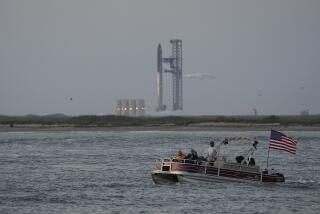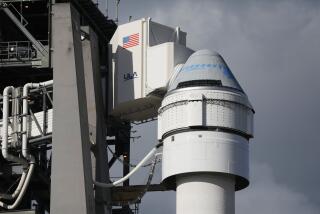Soviet Space Shuttle Makes Maiden Flight
- Share via
MOSCOW — The new Soviet space shuttle successfully completed a short, unmanned test flight, its first, early today.
Launched from the Baikonur space center in Soviet Central Asia at 6 a.m. Moscow time (7 p.m. Monday PST) by one of the Soviet Union’s giant new Energia rockets, the gleaming white, delta-wing spacecraft orbited the earth twice and landed back in Kazakhstan 3 hours and 25 minutes later, according to the official Soviet news agency Tass.
Named Buran, meaning snowstorm in Russian, the shuttle made an automated landing a few miles from where it had been launched after a flight that Tass said had gone according to plan.
Tass reported that Buran was launched on schedule despite windy, rainy weather that space officials worried might delay the test flight. The shuttle separated on schedule from the booster rocket and went into its planned orbit with a brief “two-impulse” firing of its own rocket motors, Tass said.
In its morning news program, Soviet television showed film of the launch--the bright red, orange and yellow flames from the Energia rocket contrasting with the dark blue skies of the Central Asian steppe--and of the controllers applauding the liftoff.
The launch had been postponed because of a malfunction in ground equipment during the first attempt Oct. 28, but it went smoothly today despite fears that bad weather might coat the shuttle and rocket with ice, according to Soviet radio and television reports from Baikonur.
‘Giant White Bird’
Comparing the 100-ton Buran to “a giant white bird with black plumage,” Tass described the 98-foot-long shuttle as “the pride of Soviet space technology.”
Tass, quoting Soviet space officials, said the flight was intended to be “a comprehensive flight test of the spaceship’s design and its on-board systems during liftoff, in orbit and during an automatic landing.”
Officials also hoped to “continue upgrading the booster rocket and ground flight-control systems” as a result of the flight, Tass reported.
But Buran’s own designers and engineers said earlier that they want to see, most of all, how well it lands. They said they are prepared for further problems.
“The most delicate and sensitive moment is the fully automated landing, beginning with re-entering the Earth’s atmosphere and ending with the final run along the specially built landing strip,” a correspondent for the Communist Party newspaper Pravda wrote from Baikonur on Monday.
Another Unmanned Flight
At least one more unmanned test flight is planned before the new spacecraft is used by cosmonauts, Soviet space officials said. While no date has been set for the first manned flight, a second Buran shuttle is now being assembled at Baikonur.
“Removing developmental problems will be a prolonged process of many small steps,” Pravda said, reflecting the caution of Soviet space officials who are testing not only the new spacecraft but also a new rocket system and new ground facilities at Baikonur. The testing process itself is “capricious by nature,” Pravda commented.
The first attempt to launch Buran was aborted with only 51 seconds to go when part of the ground equipment, an access arm with control mechanisms for setting the azimuthal orientation system of the spacecraft and carrier rocket, failed to pull back quickly enough to free the rocket for blastoff.
Soviet space officials said later that they considered overriding the automatic controls when it appeared there was sufficient clearance after all, but then decided that it was safer to cancel the launch. Had it been a manned mission, technicians found later, an adjacent platform with a cosmonaut escape chute would have had no time to pull away from the rocket.
That problem was corrected, officials said Monday, by simplifying the design of the equipment involved and then testing it. All the ground equipment, as well as the shuttle and the carrier rocket, had been rechecked before the refueling of the rocket began late Monday, the officials added.
For Buran’s designers, the crucial test was that of the new automated landing system, which uses a network of radio beacons to guide the spacecraft back to Baikonur. It has been tested more than 60 times on a modified TU-154 airliner and reportedly on Buran prototypes.
Soviet space officials regard the landing system as a key element in the spacecraft’s utility, allowing it to fly unmanned as a cargo ship, to return in virtually any weather conditions and to be brought down by ground controls in the event of an accident that disables the crew.
“The ‘Birdie’ is blind,” Pravda’s correspondent had written, using Baikonur’s nickname for Buran, “and no one is on board to correct its course as it comes in to land. . . . One has to be completely sure of all the automatic systems.”
If the shuttle’s test flights are successful, Buran promises to open a major new phase in the Soviet Union’s expanding space program, according to Soviet space officials, who say it would contribute to the manning and maintenance of a second-generation orbiting Mir space laboratory.
“This is like the first little whistle stop on our long journey into the universe,” Pravda commented.
Similar to U.S. Missions
Buran will also be used, Soviet officials said, to launch, retrieve and repair satellites and to conduct short-term experiments much like those on U.S. shuttles.
The shuttle is covered with 38,000 lightweight ceramic tiles that form a heat-absorbing coat, much like that of the American shuttles, to protect the spacecraft as it re-enters the Earth’s atmosphere. Soviet space officials said Buran’s tiles differ in design and composition from those on the U.S. space shuttles.
Buran’s shape resembles the American shuttles, but it does not have its own engines as the U.S. spacecraft do; instead, it is strapped piggyback on one of the new, two-stage Energia rockets, which provide both the main engines and boosters.
Prototypes also had two jet engines in the tail, apparently intended to increase maneuverability during practice landings, but they appeared from television coverage of pre-launch activities to have been dropped, and Buran presumably is designed to glide to a landing just as the American shuttles do.
Buran is designed to fly manned or unmanned, in an automatic mode or on manual controls. Its payload of 66,000 pounds is about 20% larger than that of the American shuttle.
The Energia, first tested in May, 1987, can put a 100-ton payload into Earth orbit, carry 32 tons to the moon or 28 tons as far as Mars or Venus, according to Soviet officials. Five times as powerful as the Proton, which had been the Soviet Union’s largest rocket, the 195-foot-tall Energia has a central section with four engines and then four booster rockets strapped to its sides.
The Soviet Union, like the United States, has spent about $10 billion on its shuttle, a Soviet space official told the newspaper Komsomolskaya Pravda.
More to Read
Sign up for Essential California
The most important California stories and recommendations in your inbox every morning.
You may occasionally receive promotional content from the Los Angeles Times.










